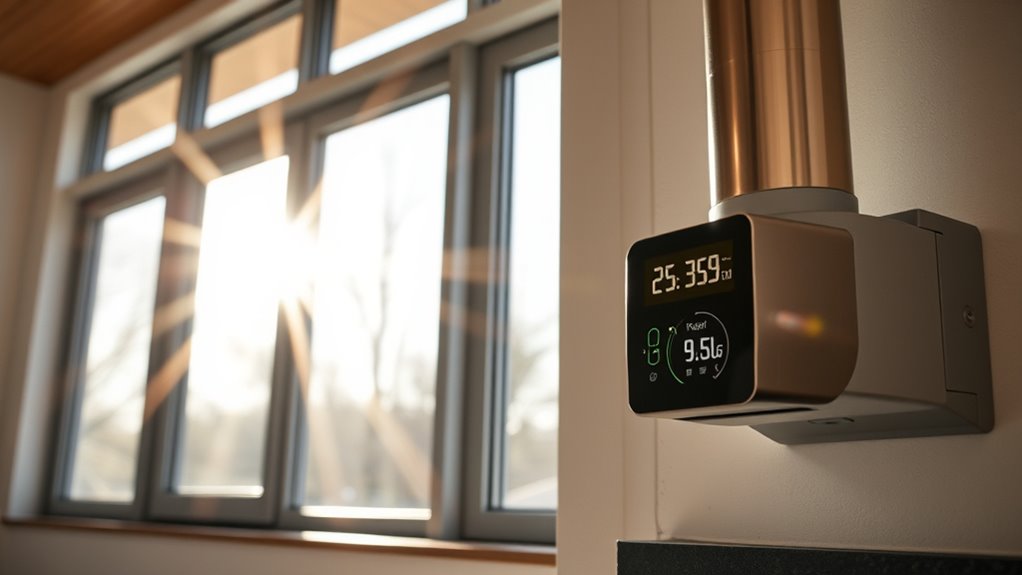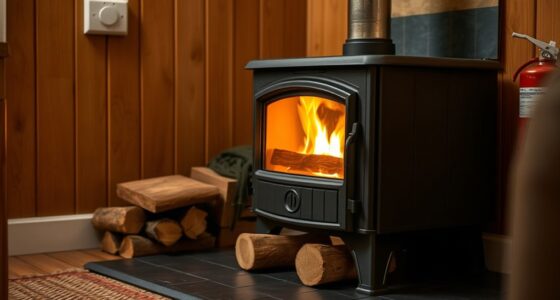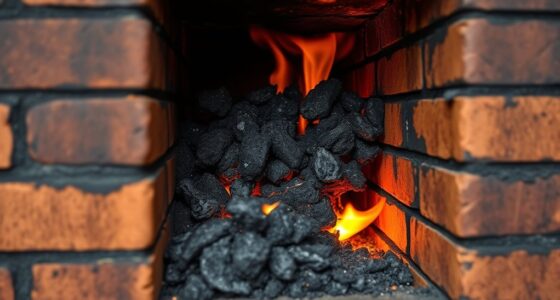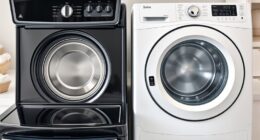In tight homes, you need to guarantee your appliances get enough combustion air to operate safely and efficiently. Since sealed homes limit passive airflow, you should install dedicated combustion air supplies or mechanical ventilation systems. Proper ventilation prevents dangerous gases like carbon monoxide from building up and keeps indoor air quality high. Continuously providing adequate combustion air is essential for safety, so understanding the best solutions will help you maintain a healthy, efficient home environment.
Key Takeaways
- Tight homes reduce passive infiltration, requiring dedicated combustion air sources for safe appliance operation.
- Adequate combustion air prevents dangerous gas buildup and ensures efficient, complete combustion of appliances.
- Ventilation standards recommend specific intake methods, such as dedicated ducts or direct air supplies, in tightly sealed homes.
- Mechanical ventilation can supplement natural air supply to meet combustion air requirements safely.
- Properly designed combustion air systems help prevent backdrafting, indoor air quality issues, and appliance damage.
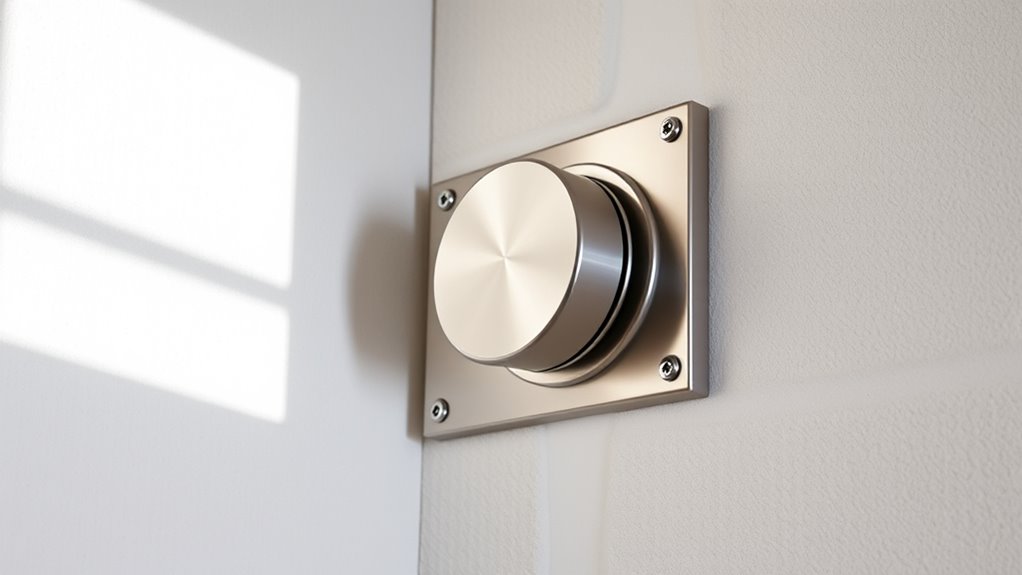
Have you ever wondered how much air a furnace or boiler needs to burn fuel efficiently? Proper combustion air is essential for safe and effective operation, especially in tight homes where space is well-sealed to improve energy efficiency. In such environments, guaranteeing the right amount of combustion air becomes a bit more complex but equally important. Ventilation standards are established to guarantee that appliances receive enough air to operate safely without risking the buildup of dangerous gases like carbon monoxide. These standards exist to protect your indoor air quality, which can deteriorate if combustion appliances don’t get sufficient oxygen. If your home is tightly sealed, it’s vital to understand that relying solely on passive air infiltration might not be enough to meet these standards, potentially leading to incomplete combustion or hazardous conditions.
Indoor air quality directly depends on providing adequate combustion air. When a furnace or boiler doesn’t get enough air, it can produce higher levels of carbon monoxide and soot, which not only threaten your health but can also damage the appliance itself. To prevent this, you need to verify your home’s ventilation standards are met, which often involves installing dedicated combustion air supplies or ensuring that existing vents are unobstructed and properly designed. These measures help maintain a healthy balance of indoor air, preventing negative effects like stale air or excessive moisture buildup. It’s essential to check that your home’s ventilation system is designed or modified to supply enough fresh air, especially if you’ve added insulation or made your home more airtight. Without proper ventilation standards, the risk of incomplete combustion increases, which can lead to dangerous indoor air quality issues.
In tight homes, passive ventilation alone might not provide enough air for appliances to operate efficiently and safely. You might need to incorporate dedicated combustion air intake systems or mechanical ventilation that explicitly supplies fresh air directly to your appliances. This ensures consistent air supply, reduces the risk of backdrafting, and helps your heating system perform at its best. Additionally, understanding the ventilation standards can help you choose the most appropriate solutions for your home’s specific needs. Remember, the goal is to eliminate any guesswork about whether your furnace or boiler has enough air, which is why adhering to established ventilation standards is vital. It’s not just about compliance; it’s about safeguarding your family’s health and maintaining a safe, comfortable home. Guaranteeing proper combustion air not only promotes efficient fuel burning but also preserves indoor air quality, making your tight home a healthier place to live.
Frequently Asked Questions
How Can I Detect Inadequate Combustion Air in My Home?
You can detect inadequate combustion air by watching for signs like flickering or yellowish flames in your appliances, which indicate poor ventilation. Use carbon monoxide detectors to monitor for dangerous gases that can accumulate from insufficient air supply. Improving ventilation strategies, such as installing exhaust fans or air vents, helps guarantee proper airflow. Regularly servicing appliances and paying attention to warning signs keep your home safe and well-ventilated.
Are There Specific Codes for Combustion Air in Tight Homes?
Like a tight lid on a jar, your home needs proper ventilation to meet building code standards. Yes, there are specific codes for combustion air in tight homes, emphasizing ventilation requirements to guarantee safety and efficiency. These codes specify how much fresh air you need and how to provide it. Following these standards helps prevent dangerous buildup of gases and ensures your appliances operate safely, giving you peace of mind.
What Are the Common Signs of Poor Combustion Air Supply?
You might notice yellow or flickering flames, increased condensation, or inconsistent heating, which are signs of poor combustion air supply. These ventilation issues can lead to safety hazards like carbon monoxide buildup or inefficient appliance operation. If you observe such symptoms, it’s vital to improve airflow and guarantee proper ventilation, preventing dangerous conditions and maintaining safe, efficient functioning of your heating appliances.
Can Indoor Plants Improve Combustion Air Quality?
Indoor plants can improve indoor air quality by filtering pollutants and increasing humidity, which benefits overall indoor air. While they don’t specifically enhance combustion air, plant benefits include reducing indoor toxins and creating a fresher environment. Better indoor air quality can help you breathe easier and may indirectly support healthier combustion processes by maintaining a cleaner, more balanced indoor atmosphere. Keep plants in well-ventilated areas for best results.
How Does Weather Affect Combustion Air Needs in Tight Homes?
Weather fluctuations dramatically impact your home’s combustion air needs. When outdoor ventilation drops on chilly days, your tight home struggles to get enough air for appliances, risking safety. Hot, humid weather can do the opposite—flooding your home with excess moisture, complicating combustion. So, you better stay alert, because weather swings can turn your home’s air supply into a rollercoaster ride, demanding your constant attention and perhaps some clever ventilation solutions.
Conclusion
Understanding combustion air requirements in tight homes is like trying to keep a delicate flame alive in a windless room—you need just the right amount of fresh air to prevent dangerous buildups. By ensuring proper ventilation, you safeguard your home’s safety and efficiency. Remember, neglecting these needs can turn a cozy sanctuary into a hidden hazard. Keep the airflow steady, and your home will breathe easy, shining bright like a lantern in a dark night.

